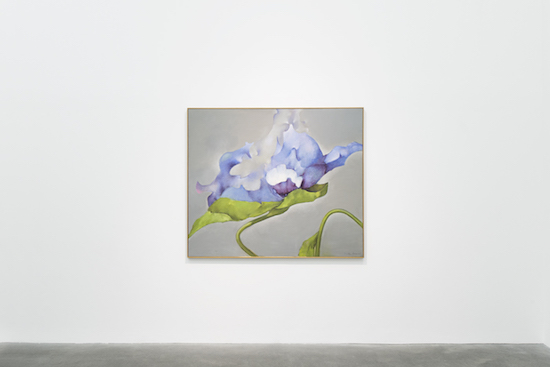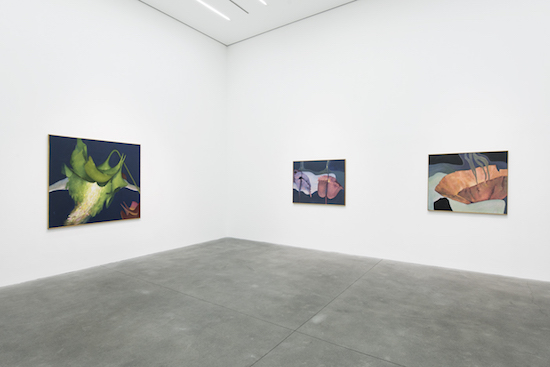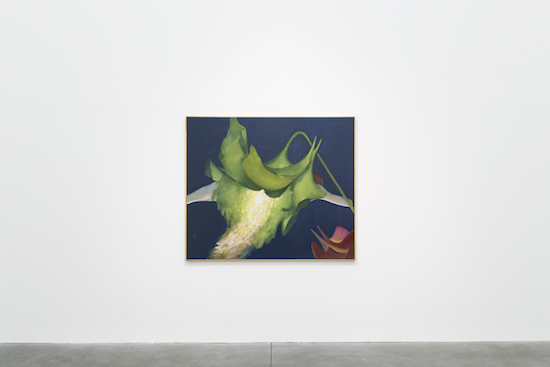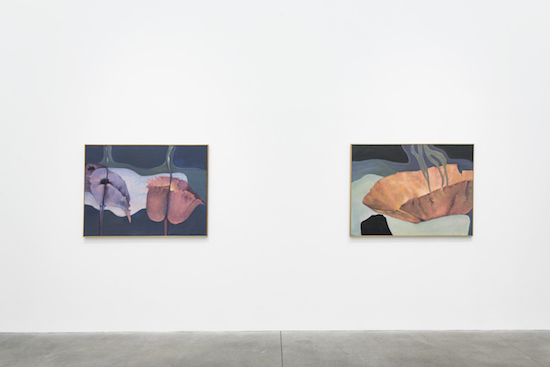All images: Courtesy Alison Jacques Gallery, London and The Destina Foundation, New York, Copyright The Destina Foundation, New York, Photo Michael Brzezinski
In the spring of 1921, a Polish rare book dealer named Wilfrid Voynich delivered a lecture to the Philadelphia College of Physicians in which he discussed for the first time in public a manuscript he claimed to have discovered nine years earlier amongst a collection purchased from the executors of a castle in southern Europe. Though no bigger than a paperback Penguin Classic and only 234 pages long, the book – which has come to be known after its finder as the Voynich Manuscript – has since grown into one of the greatest mysteries of the twentieth century.
Written in a clear, neat handwriting in an alphabet which corresponds to no known language, the text is richly illustrated with detailed colour images of plants which depart significantly from any terrestrial flora. It has been variously suggested that the script may represent an attempted transliteration of some exotic natural language, written in the field and invented on the fly by some occidental explorer. But if so it has proven hitherto untranslatable and its symbolism remains unrecognised by scores of anthropologists. Or perhaps the automatic writing of someone in a trance state, somewhere between the Lingua ignota of medieval visionary Hildegard von Bingen and the ‘Ultramartian’ of the nineteenth century French psychic Hélène Smith. But if so it’s structure and the statistical distribution of its characters belie any suggestion of randomness.
It has even been suggested that it might be an early modern book of coded secrets. But if so it has foxed the attempts at decipherment of some of the twentieth century’s greatest cryptographers, from John Tiltman, one of the highest ranking colonels at Bletchley Park, to William Friedman, the American who broke the Japanese ‘Purple’ code.
The very few concrete clues to its provenance are themselves contradictory: a letter, supposedly found amongst the book’s pages and addressed to the Jesuit polymath Athanasius Kircher, attributes its construction to the thirteenth century Franciscan philosopher, Roger Bacon; while a recent carbon dating assigns a mid-fifteenth century origin to the vellum sheets on which the book is written.
The Voynich Manuscript remains a mystery. Its carefully delineated plants and flowers offer few clues to their origin. Who knows? Perhaps they come simply from the imagination of a great poet and illustrator – like another set of make-believe blooms, first shown in New York some eighty-five years after Wilfrid Voynich revealed his book, and currently on display in London.

When she was seven years old, Dorothea Tanning drew a figure with leaves for hair. "Was I a tiny surrealist?" she asks in her autobiography. "Are all children surrealists, visually? Maybe surrealist painters with children with years, playing with the irrational. Maybe they knew that antic imagination is fun."
Born in Galesburg, Illinois, in August 1910, Tanning discovered surrealism at the Museum of Modern Art in New York, shortly after she moved there, in 1936. She found there "a limitless expanse of POSSIBILITY, a perspective having only incidentally to do with painting on surfaces." By that time the Julien Levy Gallery had already been showing surrealist artists for some four years – and a little over four years later, Levy would give Tanning her first solo show as a painter, too. It was Levy who introduced Tanning, in 1943, to Max Ernst, who would be her husband for thirty years. They would travel to chess tournaments with Duchamp, spend long evenings playing games devised by André Breton: The Game of Truth, The Blindfold Game, The Game of Murder.
She was 86 by the time she painted the six glorious canvases that dominate the present show at Alison Jacques Gallery in London. In fact, she thought, by then, that she was done with painting. Back in New York for some years since Ernst’s death in 1976, she had been concentrating lately on her writing, with several books of poems to her name. But then she remembered that set of stretched canvases leaning against a wall in her studio, purchased years earlier from Lefebvre-Foinet’s legendary art supply shop in Paris. The image of a flower – an impossible hybrid, unknown by any botanist – "grew," she wrote, "in my mind’s eye and demanded to be painted" on one June day in 1997.
In a flurry of activity, she finished twelve canvases in six months, each one more than a meter across and nearly as tall. Twelve poets were invited to name them and compose odes to them which were published, alongside reproductions of the works themselves, in a 1998 book called Another Language of Flowers.
Pistil, stamen and bract
but never abstract:
the flower becomes the eye
we see her by.
– Adrienne Rich, "Pictor mysteriosa (Burnt Umbrage)"

Unlike the mysterious flora in the Voynich Manuscript, Tanning’s plants have a hazy, impressionistic appearance, as if glimpsed in a dream. The petals of her Pictor mysteriosa have the texture of a bruised peach. Convolotus alchemelia seems almost to be dematerialising in front of you, its tender fronds evanescing into the washed-out grey of the canvas background.
A certain gothic spiritualism had long pervaded Tanning’s work. For her, the link between the mediumistic trance and Surrealist automatic writing was always very apparent. But despite the spontaneity of their origins, there is nothing like an "automatic painting" about these flowers. The oiled canvases are exhibited alongside smaller preliminary sketches, each graphite on vellum with just the occasional drop of water colour paint or tender smudge of red pencil.
The Sketch for Zephirium apochripholiae (Windwort) (1997) looks at first glance almost totally indistinct, a rash of scribbles at varying intensities. But its form is almost identical to the finished painting. What remains, nonetheless, impossible to see in the sketch but emerges strongly on the canvas is the image of a naked female body, buckled over behind the flower. The deep blue void of the plant’s Gynoecium suggestively covers the woman’s sexual organs. The same gesture is repeated in several of the other paintings, including Agripedium vorax Saccherii (Clog Herb) (1997) and Victrola floribunda(1997). Still, one could almost miss these corporal forms, almost featureless, on the verge of abstraction. What you see is not so much a woman lying amongst flowers, as woman and flower obscurely juxtaposed, floating in space – or even, alternating in one’s attention, like the famous illusion of the duck-rabbit.

"For Tanning," wrote Katharine Conley in her book Surrealist Ghostliness, "the female body invites reimagination as a forcefully whole human being, at once intellectual and sensual, fully attuned to lived human experience and ready for Foucault’s visualisation of Bretonian automatism as a kind of "raw and naked" possession by inner voices that led to "the discovery of a space that is not that of philosophy, nor of literature, nor of art, but that of experience."
Having espied me scribbling in my notebook, another visitor to the gallery, an older woman, turned to me suddenly and said, "What do you think of her as a colourist?"
I told her I thought a great deal of her as a colourist and we gazed for a while together at the rich, vivid hues, the tender, fleshy texture of the Pictor mysteriosa. "Isn’t she just amazing," the woman replied, her eyes fully aglow. A little later, staring on her own at another canvas, I’m sure I heard her let out an involuntary sotto voce "wow".
Dorothea Tanning, Flower Paintings, is at Alison Jacques until 1 October


